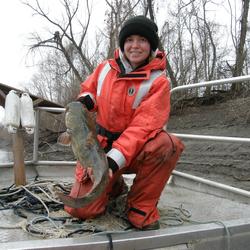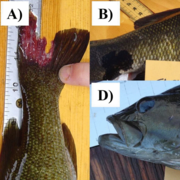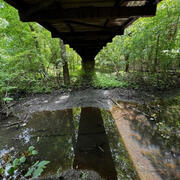This USGS map shows the number of PFAS detected in tap water samples from select sites across the nation. The findings are based on a USGS study of samples taken between 2016 and 2021 from private and public supplies at 716 locations. The map does not represent the only locations in the U.S. with PFAS.
Kelly Smalling
I am interested in the exposure and effects of contaminants including current-use pesticides and other endocrine active compounds on fish and wildlife with a focus on amphibian populations.
I am an environmental organic chemist who has been working with the USGS since 2004. My current research focuses on the occurrence, fate and effects of emerging contaminants including current-use pesticides in the environment. I am the lead for the Amphibian Research and Monitoring Initiative's Contaminants Project, the project coordinator of the "EDC effects on fish and wildlife in the Cheseapeake Bay Watershed" project through the Contaminants Biology Program, and a member of the Toxic Substances Hydrology Program's Pesticide Fate Research Team.
Education and Certifications
BS in Chemistry from the University of Alabama in Huntsville in 1999
MSPH in Environmental Health Science from the University of South Carolina in 2003
Science and Products
Invasive flathead catfish now top predators in Susquehanna River in Pennsylvania
A regional assessment of fish health in the Chesapeake Bay watershed
Per and Polyfluoroalkyl Substances (PFAS) in New Jersey surface waters
Understanding the Dynamics of Per- and Polyfluoroalkyl Substances (PFAS): Insights from USGS Research
Beneath the Surface: Exploring PFAS and Drinking Water on French Island, Wisconsin
Preliminary Research Sheds Light on Proper Analysis and Sample Handling for the Tire-Derived Contaminants 6PPD and 6PPD-quinone
Drinking Water and Wastewater Infrastructure Science Team
USGS Scientists Develop an Interactive Mapping Tool to Visualize PFAS in Tap Water
Improving Understanding and Coordination of Science Activities for Per- and Polyfluoroalkyl Substances (PFAS) in the Chesapeake Bay Watershed
Collaborative Science Provides Understanding of Contaminants in Bottled Water-an Increasingly Common Alternate Drinking Water Source
USGS Integrates Findings about Endocrine-Disrupting Compounds in the Chesapeake Watershed
Inorganic and Organic Chemical Mixtures Detected in both Public and Private Tap Water in Cape Cod, Massachusetts
Presumptive sources and relative heat index of 6PPD-quinone at the NHDPlusV2 catchment scale across the conterminous U.S. Presumptive sources and relative heat index of 6PPD-quinone at the NHDPlusV2 catchment scale across the conterminous U.S.
Contaminants in bed sediment from surface waters collected in the Chesapeake Bay Watershed, 2021-24 Contaminants in bed sediment from surface waters collected in the Chesapeake Bay Watershed, 2021-24
Chemical concentration results for assessment of mixed-organic/inorganic chemical exposures in the southeast United States, beginning 2022 Chemical concentration results for assessment of mixed-organic/inorganic chemical exposures in the southeast United States, beginning 2022
Per- and polyfluoroalkyl substances (PFAS) results in tapwater samples, in select areas within the United States, beginning 2023 (ver. 2.0, June 2025) Per- and polyfluoroalkyl substances (PFAS) results in tapwater samples, in select areas within the United States, beginning 2023 (ver. 2.0, June 2025)
Mercury concentrations in amphibian tissues and egg masses, fish tissues and sediment in subarctic, freshwater systems near Churchill, Manitoba, 2015-2019 Mercury concentrations in amphibian tissues and egg masses, fish tissues and sediment in subarctic, freshwater systems near Churchill, Manitoba, 2015-2019
Predictions of PFAS in groundwater used as a source of drinking water and related data in the conterminous United States Predictions of PFAS in groundwater used as a source of drinking water and related data in the conterminous United States
Concentrations of 6PPD and 6PPD-Quinone in a United States reconnaissance of stormwater, surface water, and groundwater, 2018-24 Concentrations of 6PPD and 6PPD-Quinone in a United States reconnaissance of stormwater, surface water, and groundwater, 2018-24
Nutrient and trace element results for the U.S. Geological Survey vernal ponds study, Pleasant Grove, New Jersey, 2022-23 Nutrient and trace element results for the U.S. Geological Survey vernal ponds study, Pleasant Grove, New Jersey, 2022-23
Arsenic concentration results utilizing a novel field integrated biosensor system, New Hampshire, 2019 Arsenic concentration results utilizing a novel field integrated biosensor system, New Hampshire, 2019
Quarterly sample results for per- and polyfluoroalkyl substances (PFAS) for locations in Campbell, Wisconsin, 2021-24 (ver. 2.0, March 2025) Quarterly sample results for per- and polyfluoroalkyl substances (PFAS) for locations in Campbell, Wisconsin, 2021-24 (ver. 2.0, March 2025)
Target-Chemical Concentrations for Assessment of Mixed-Organic/Inorganic Chemical and Biological Exposures in Private-Well Tapwater at Campbell, Wisconsin, 2021 Target-Chemical Concentrations for Assessment of Mixed-Organic/Inorganic Chemical and Biological Exposures in Private-Well Tapwater at Campbell, Wisconsin, 2021
Target-chemical concentrations and microbiological results in surface water and tapwater, Montana, 2022 Target-chemical concentrations and microbiological results in surface water and tapwater, Montana, 2022
This USGS map shows the number of PFAS detected in tap water samples from select sites across the nation. The findings are based on a USGS study of samples taken between 2016 and 2021 from private and public supplies at 716 locations. The map does not represent the only locations in the U.S. with PFAS.
A USGS scientist wearing black gloves is collecting a sample of tap water from the kitchen sink using small plastic vials to test for PFAS.
A USGS scientist wearing black gloves is collecting a sample of tap water from the kitchen sink using small plastic vials to test for PFAS.
USGS scientists collect water samples for chemical analysis from an excavated pond in the NJ Pinelands.
USGS scientists collect water samples for chemical analysis from an excavated pond in the NJ Pinelands.
Treading water: How 6PPD-quinone makes it to our local water bodies & what it means for sensitive fish species Treading water: How 6PPD-quinone makes it to our local water bodies & what it means for sensitive fish species
Tapwater-contaminant mixtures and risk in a biofuel-facility impacted private-well community Tapwater-contaminant mixtures and risk in a biofuel-facility impacted private-well community
Insights and strategic opportunities from the USGS 2024 Per- and Polyfluoroalkyl Substances (PFAS) Interagency Workshop Insights and strategic opportunities from the USGS 2024 Per- and Polyfluoroalkyl Substances (PFAS) Interagency Workshop
Decoupling the roles of corticosterone in mediating effects of methylmercury and chytrid fungus on amphibian survival Decoupling the roles of corticosterone in mediating effects of methylmercury and chytrid fungus on amphibian survival
Deformity, erosion, lesion, tumor, and parasite (DELT) anomalies in fish communities of the Chesapeake Bay watershed, USA: A regional assessment and potential landscape drivers Deformity, erosion, lesion, tumor, and parasite (DELT) anomalies in fish communities of the Chesapeake Bay watershed, USA: A regional assessment and potential landscape drivers
Municipal and industrial wastewater treatment plant effluent contributions to per- and polyfluoroalkyl substances in the Potomac River: A basin-scale measuring and modeling approach Municipal and industrial wastewater treatment plant effluent contributions to per- and polyfluoroalkyl substances in the Potomac River: A basin-scale measuring and modeling approach
Independent and interactive effects of disease and methylmercury on demographic rates across multiple amphibian populations Independent and interactive effects of disease and methylmercury on demographic rates across multiple amphibian populations
Tapwater exposures, residential risk, and mitigation in a PFAS-impacted-groundwater community Tapwater exposures, residential risk, and mitigation in a PFAS-impacted-groundwater community
Statewide cumulative human health risk assessment of inorganics-contaminated groundwater wells, Montana, USA Statewide cumulative human health risk assessment of inorganics-contaminated groundwater wells, Montana, USA
Methylmercury in subarctic amphibians: Environmental gradients, bioaccumulation, and estimated flux Methylmercury in subarctic amphibians: Environmental gradients, bioaccumulation, and estimated flux
Public, bottled, and private drinking water: Shared contaminant-mixture exposures and effects challenge Public, bottled, and private drinking water: Shared contaminant-mixture exposures and effects challenge
Temporal concentrations of Quaternary ammonium compounds in wastewater treatment effluents during the COVID-19 pandemic, 2020–2021 Temporal concentrations of Quaternary ammonium compounds in wastewater treatment effluents during the COVID-19 pandemic, 2020–2021
Non-USGS Publications**
**Disclaimer: The views expressed in Non-USGS publications are those of the author and do not represent the views of the USGS, Department of the Interior, or the U.S. Government.
PFAS in US Tapwater Interactive Dashboard PFAS in US Tapwater Interactive Dashboard
Drop by Drop Drop by Drop
R scripts for the analysis of a predatory fish invasion on a riverine food web R scripts for the analysis of a predatory fish invasion on a riverine food web
The effects of wastewater reuse on smallmouth bass (Micropterus dolomieu) relative abundance in the Shenandoah River Watershed, USA The effects of wastewater reuse on smallmouth bass (Micropterus dolomieu) relative abundance in the Shenandoah River Watershed, USA
Per- and Polyfluoroalkyl Substances (PFAS) in U.S. Tapwater: Comparison of Public-Supply and Underserved Private-Well Exposures and Associated Health Implications Per- and Polyfluoroalkyl Substances (PFAS) in U.S. Tapwater: Comparison of Public-Supply and Underserved Private-Well Exposures and Associated Health Implications
Science and Products
Invasive flathead catfish now top predators in Susquehanna River in Pennsylvania
A regional assessment of fish health in the Chesapeake Bay watershed
Per and Polyfluoroalkyl Substances (PFAS) in New Jersey surface waters
Understanding the Dynamics of Per- and Polyfluoroalkyl Substances (PFAS): Insights from USGS Research
Beneath the Surface: Exploring PFAS and Drinking Water on French Island, Wisconsin
Preliminary Research Sheds Light on Proper Analysis and Sample Handling for the Tire-Derived Contaminants 6PPD and 6PPD-quinone
Drinking Water and Wastewater Infrastructure Science Team
USGS Scientists Develop an Interactive Mapping Tool to Visualize PFAS in Tap Water
Improving Understanding and Coordination of Science Activities for Per- and Polyfluoroalkyl Substances (PFAS) in the Chesapeake Bay Watershed
Collaborative Science Provides Understanding of Contaminants in Bottled Water-an Increasingly Common Alternate Drinking Water Source
USGS Integrates Findings about Endocrine-Disrupting Compounds in the Chesapeake Watershed
Inorganic and Organic Chemical Mixtures Detected in both Public and Private Tap Water in Cape Cod, Massachusetts
Presumptive sources and relative heat index of 6PPD-quinone at the NHDPlusV2 catchment scale across the conterminous U.S. Presumptive sources and relative heat index of 6PPD-quinone at the NHDPlusV2 catchment scale across the conterminous U.S.
Contaminants in bed sediment from surface waters collected in the Chesapeake Bay Watershed, 2021-24 Contaminants in bed sediment from surface waters collected in the Chesapeake Bay Watershed, 2021-24
Chemical concentration results for assessment of mixed-organic/inorganic chemical exposures in the southeast United States, beginning 2022 Chemical concentration results for assessment of mixed-organic/inorganic chemical exposures in the southeast United States, beginning 2022
Per- and polyfluoroalkyl substances (PFAS) results in tapwater samples, in select areas within the United States, beginning 2023 (ver. 2.0, June 2025) Per- and polyfluoroalkyl substances (PFAS) results in tapwater samples, in select areas within the United States, beginning 2023 (ver. 2.0, June 2025)
Mercury concentrations in amphibian tissues and egg masses, fish tissues and sediment in subarctic, freshwater systems near Churchill, Manitoba, 2015-2019 Mercury concentrations in amphibian tissues and egg masses, fish tissues and sediment in subarctic, freshwater systems near Churchill, Manitoba, 2015-2019
Predictions of PFAS in groundwater used as a source of drinking water and related data in the conterminous United States Predictions of PFAS in groundwater used as a source of drinking water and related data in the conterminous United States
Concentrations of 6PPD and 6PPD-Quinone in a United States reconnaissance of stormwater, surface water, and groundwater, 2018-24 Concentrations of 6PPD and 6PPD-Quinone in a United States reconnaissance of stormwater, surface water, and groundwater, 2018-24
Nutrient and trace element results for the U.S. Geological Survey vernal ponds study, Pleasant Grove, New Jersey, 2022-23 Nutrient and trace element results for the U.S. Geological Survey vernal ponds study, Pleasant Grove, New Jersey, 2022-23
Arsenic concentration results utilizing a novel field integrated biosensor system, New Hampshire, 2019 Arsenic concentration results utilizing a novel field integrated biosensor system, New Hampshire, 2019
Quarterly sample results for per- and polyfluoroalkyl substances (PFAS) for locations in Campbell, Wisconsin, 2021-24 (ver. 2.0, March 2025) Quarterly sample results for per- and polyfluoroalkyl substances (PFAS) for locations in Campbell, Wisconsin, 2021-24 (ver. 2.0, March 2025)
Target-Chemical Concentrations for Assessment of Mixed-Organic/Inorganic Chemical and Biological Exposures in Private-Well Tapwater at Campbell, Wisconsin, 2021 Target-Chemical Concentrations for Assessment of Mixed-Organic/Inorganic Chemical and Biological Exposures in Private-Well Tapwater at Campbell, Wisconsin, 2021
Target-chemical concentrations and microbiological results in surface water and tapwater, Montana, 2022 Target-chemical concentrations and microbiological results in surface water and tapwater, Montana, 2022
This USGS map shows the number of PFAS detected in tap water samples from select sites across the nation. The findings are based on a USGS study of samples taken between 2016 and 2021 from private and public supplies at 716 locations. The map does not represent the only locations in the U.S. with PFAS.
This USGS map shows the number of PFAS detected in tap water samples from select sites across the nation. The findings are based on a USGS study of samples taken between 2016 and 2021 from private and public supplies at 716 locations. The map does not represent the only locations in the U.S. with PFAS.
A USGS scientist wearing black gloves is collecting a sample of tap water from the kitchen sink using small plastic vials to test for PFAS.
A USGS scientist wearing black gloves is collecting a sample of tap water from the kitchen sink using small plastic vials to test for PFAS.
USGS scientists collect water samples for chemical analysis from an excavated pond in the NJ Pinelands.
USGS scientists collect water samples for chemical analysis from an excavated pond in the NJ Pinelands.
Treading water: How 6PPD-quinone makes it to our local water bodies & what it means for sensitive fish species Treading water: How 6PPD-quinone makes it to our local water bodies & what it means for sensitive fish species
Tapwater-contaminant mixtures and risk in a biofuel-facility impacted private-well community Tapwater-contaminant mixtures and risk in a biofuel-facility impacted private-well community
Insights and strategic opportunities from the USGS 2024 Per- and Polyfluoroalkyl Substances (PFAS) Interagency Workshop Insights and strategic opportunities from the USGS 2024 Per- and Polyfluoroalkyl Substances (PFAS) Interagency Workshop
Decoupling the roles of corticosterone in mediating effects of methylmercury and chytrid fungus on amphibian survival Decoupling the roles of corticosterone in mediating effects of methylmercury and chytrid fungus on amphibian survival
Deformity, erosion, lesion, tumor, and parasite (DELT) anomalies in fish communities of the Chesapeake Bay watershed, USA: A regional assessment and potential landscape drivers Deformity, erosion, lesion, tumor, and parasite (DELT) anomalies in fish communities of the Chesapeake Bay watershed, USA: A regional assessment and potential landscape drivers
Municipal and industrial wastewater treatment plant effluent contributions to per- and polyfluoroalkyl substances in the Potomac River: A basin-scale measuring and modeling approach Municipal and industrial wastewater treatment plant effluent contributions to per- and polyfluoroalkyl substances in the Potomac River: A basin-scale measuring and modeling approach
Independent and interactive effects of disease and methylmercury on demographic rates across multiple amphibian populations Independent and interactive effects of disease and methylmercury on demographic rates across multiple amphibian populations
Tapwater exposures, residential risk, and mitigation in a PFAS-impacted-groundwater community Tapwater exposures, residential risk, and mitigation in a PFAS-impacted-groundwater community
Statewide cumulative human health risk assessment of inorganics-contaminated groundwater wells, Montana, USA Statewide cumulative human health risk assessment of inorganics-contaminated groundwater wells, Montana, USA
Methylmercury in subarctic amphibians: Environmental gradients, bioaccumulation, and estimated flux Methylmercury in subarctic amphibians: Environmental gradients, bioaccumulation, and estimated flux
Public, bottled, and private drinking water: Shared contaminant-mixture exposures and effects challenge Public, bottled, and private drinking water: Shared contaminant-mixture exposures and effects challenge
Temporal concentrations of Quaternary ammonium compounds in wastewater treatment effluents during the COVID-19 pandemic, 2020–2021 Temporal concentrations of Quaternary ammonium compounds in wastewater treatment effluents during the COVID-19 pandemic, 2020–2021
Non-USGS Publications**
**Disclaimer: The views expressed in Non-USGS publications are those of the author and do not represent the views of the USGS, Department of the Interior, or the U.S. Government.
















